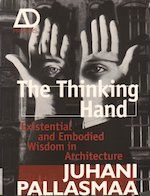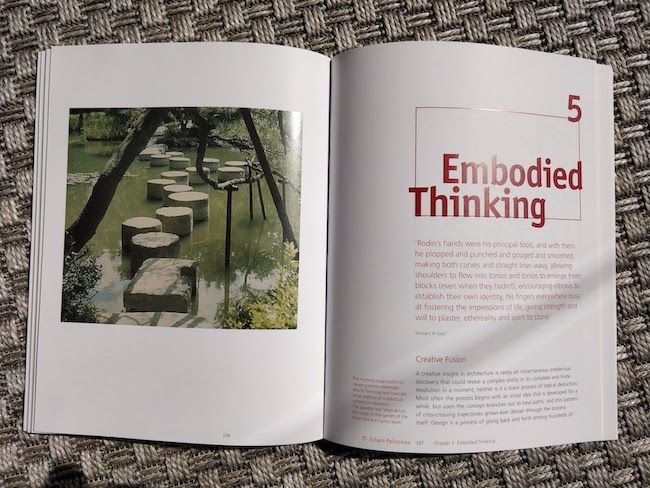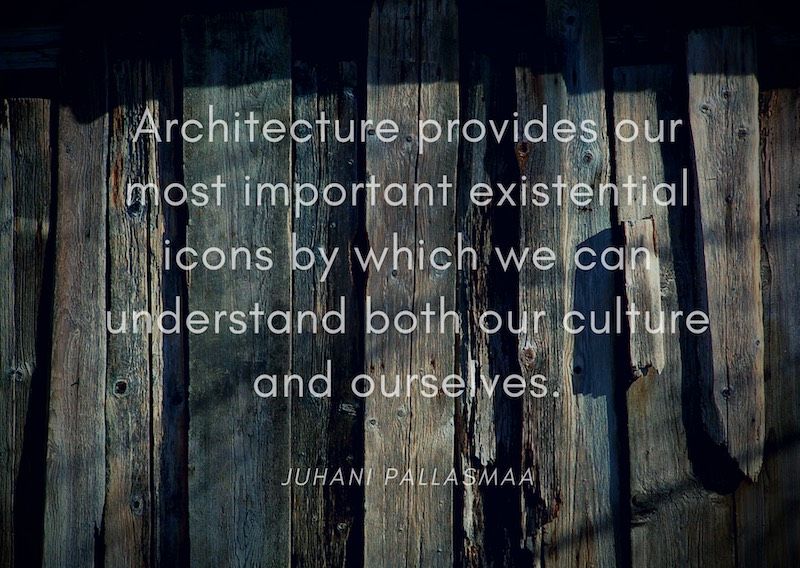The Thinking Hand Existential and Embodied Wisdom in Architecture by Juhani Pallasmaa
Introduction

This book reads as a follow on from the book The Eyes of The Skin by the same author. While The Eyes of the Skin is a beautiful text on the importance of the other senses, apart from touch, on design The Thinking Hand expands this observation and builds around the same themes to provide an overall theory of design practice and thinking emanating from the human body and all the senses.
Every chapter pretty much could stand on its own having their origins in separate essays. Each has its own closely argued references all given at the end of the chapter so although the writing is dense the argument is clear and it is fairly easy to go one chapter at a time.
I have enclosed the notes I took on each Chapter as I want to give a fairly detailed overview of the arguments presented. I hope this gives a good feeling for the style and substance of the arguments in the book. Then I will offer an overall conclusion. But in short I highly recommend this book and think it offers the design student much to ponder.
Chapter 1 The Mysterious Hand
The hand is the window to the mind
Immanuel Kant
Here Pallasmaa looks at the hand and argues how it not only describes a person well but that it’s evolutionary position is key to the evolution of language.
Current theories suggesting that language originates in early collective tool manufacture and tool use imply that even the development of language is linked with the co-evolution of the hand and the brain.
Juhani Pallasmaa p.34
The hand is the primary tool through which we interact with the world, the primary tool with which we shape it and maybe even the primary tool through which we understand it.
The development of hands may go ‘hand in hand’ with the development of consciousness and the emergence of tools.
The hand as symbol and gestures of the hand have an emotive power.

A Chiromantic hand from Jean Belot’s Ouvers (Lyons 1649)
Chapter 2 The Working Hand
From the hand the argument is developed through to tools and to tools as an extension of the hand. This is the longest chapter and where the first key argument of the book starts to take shape.
The craftsman should use of the appropriate tool for the task at hand. This extends to software as well as hardware in the modern world though that’s another subject.
Traditional craft models talked about eg. Finnish traditional church boats, basket making, building restoration.
First, that all skills, even the most abstract, begin as bodily practices; second, that technical understanding develops through the powers of imagination: The first argument focusses on knowledge gained in the hand through touch and movement. the argument about imagination begins by exploring the language that attempts to direct and guide the body.
Richard Sennet quoted by Pallasmaa p.53
The craftsman needs to embody the tool or instrument, and internalise the nature of the material he is working on.
Pallasmaa also speculates that physical models are incomparable aids in the design process of the architect. It would be interesting to check back on this argument now as tablet technology is fast catching up with the traditional pencil and paper.
While drawing, a mature designer and architect is not focused on the lines of the drawing, as he is envisioning the object itself, and in his mind holding the object in his hand or occupying the space being designed. The tool should offer no friction to this process.
Drawings and Models
Drawings and models have the double purpose of facilitating the design process itself and mediating the design ideas to others.
Architects must be able to communicate their ideas to master craftsmen and other design professionals. The modern building is a collaborative effort.
Architecture as Workmanship
The architectural profession was traditionally regarded as a craft.
Renzo Piano emphasises the ‘circularity’ of his design process - the repeated shifting from sketching to drawing to model building and testing and back again.
Chapter 3 Eye-Hand-Mind Fusion
Notes about skill development of craftsmanship concepts to create ‘art’
There are two categories of workmanship- workmanship of risk and workmanship of certainty - (not sure I agree with this does it make sense within the overall ideas presented in this book).
Sketching free of preconceptions having absorbed the brief is a way into the artist conception of creation, apart from the requirements of the brief.
Sennett defines skill as a trained practice.
Simplicity is not the end of art, but one arrives at simplicity in spite of oneself, in approaching the real essence off things, simplicity is at bottom complexity and one must be nourished on its essence to understand its significance.
Constantin Brancusi as quoted on p.81
I never seek to make what they call a pure or abstract form. Pureness, simplicity is never in my mind; to arrive at the real sense of things is the one aim’
Also Constantin Brancusi
Eye, Hand and Mind
Combination of craft and inspiration shape the artists work.

Chapter 4 The Drawing Hand
Drawing and the Self
Sketching and drawing are spatial and haptic exercises that fuse the external reality of space and matter, and the internal reality of perception, thought and mental imagery into singular and dialectic entities.
Juhani Pallasmaa p89
Sketching is an exercise in discovery and understanding. It’s not neutral it’s not like taking a photo, but an interraction.
The Computerised Hand
Benefits of computerisation of Architectural practise are many but it’s a different tool. Need to learn to sketch model first, a full array of tools should be used.
Primacy of touch : Hapticity of Self-image
The unconscious touch is the artistic experience in many ways.
Chapter 5 Embodied Thinking
Creative Fusion
A creative insight in architecture is rarely an instantaneous intellectual discovery that could reveal a complex entity in its complete and finite resolution in a moment neither is it a linear process of logical deduction.
Juhani Pallasmaa p.107
In other words design is an iterative process. Sometimes you can develop some ideas and sometimes you have to rethink or completely start again.
The Work of thinking: The Vale of Uncertainty.
Creative Thinking is work, labour, in the proper meaning of the word, rather than merely an unexpected and effortless flash of insight.
Uncertainty and insecurity are valuable in the creative endeavour. There is an inherent opposition between definite and indefinite in art, and the reconciliation of these things is a process too in the creative work.
Resistance, Tradition and Freedom
Strength is born from constraints and dies in freedom.
Leonardo Da Vinci as quoted on p112
Limits and restrictions are important to the creative process as these force discipline and innovation.
The greatest liberty is born from the greatest rigour.
Paul Valery as quoted on p113
Thinking Through the Senses
All significant architecture is a result of serious thinking - or, more precisely, of a distinct way of thinking through a medium of architecture. Architects have to embrace this process.
In my view, architecture turns similarly into mere aesthetics when it departs from its originary motives of domesticating space and time, an animistic understanding of the world, and the metaphoric representation of the act of construction.
Juhani Pallasmaa p.115
Embodied Memory and Thought

Architecture is grounded in human embodiment. The body is also part of our system of memory. An Architect should work with his entire body and sense of self the existential knowledge of existence if you like.
Chapter 6 Body, Self and Mind
During its emergence, the creative work calls for two simultaneous foci/ the world and the self; and as a consequence of its double focus every profound work is essentially a microcosmic representation of the world and an unconscious self/ portrait at the same time.
Juhani Pallasmaa
The Architectural design has a double focus inwards towards the self and outwards to the world. A reflection of the world into personal experience and back out to the universal.
Chapter 7 Emotion and Imagination.
Reality of Imagination
Our unique gift is our capacity for imagination. The imagination isn’t just a creative process but it’s the means through which we deal with the outside world, with the processing of our sense information.
Experience, memory and imagination are qualitatively equal in our consciousness.
The relationship between fiction and reality is turning upside down […..] we are increasingly living in a world fictions, and that is why the writer’s task is not to invent fiction. Fictions are already here, and thus the writer’s task is rather to invent reality.
JG Ballard in Crash as quoted on p.133
A work of art or architecture is not a symbol that represents or indirectly portrays something outside of itself. It is an image object.
The experience of art and architecture - architecture is not experienced as a set of isolated images but a fully integrated experience.
Chapter 8 Theory and Life
Be suspicious of over theorising especially of your own work. In the act of artistic making, a theoretical or intellectual consciousness has to be suppressed if not entirely forgotten.
Artistic work is always a form of collaboration. Building require whole teams of designers and craftsmen and an economic and legal structure bounding that to come into existence.

The Task of Art
The human experience, existential space. Silence.
Conclusion
A carefully and beautifully expressed argument. Our hands and our tools are extensions of the embodied mind. What we can do with these tools is an exploration of imagination and of bridging a divide between ourselves and what is outwardly possible.
We might observe that like riding a bike the key insight of this book can only be accessed through learning by doing. But this book gives us an insight into this, gives self-awareness and so philosophical muscle.
The books Uber Finnish nature can be a little overpowering. There are a well of artistic and architectural examples drawn upon but these are pretty narrow and convey a particular aesthetic. The nature of these reminds me of the type of monoculture as purveyed often in a certain type of Finnish design language that speaks of Aalto, Artek, Marimekko a classical modernism the aspires to timelessness but while the best achieves this some appears terribly dated.
A reader could easily take the lessons through, and apply it how they want in their discovery of their own design language. A timeless lesson is still to be found within the pages of this book.